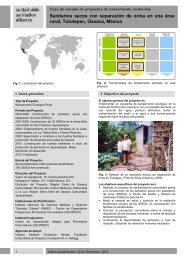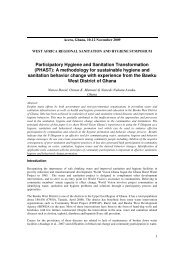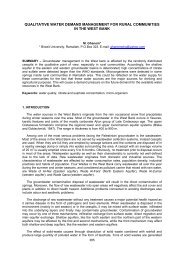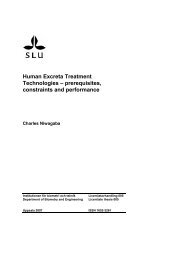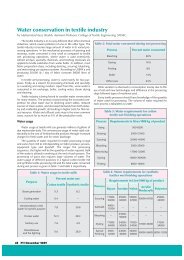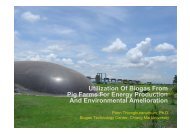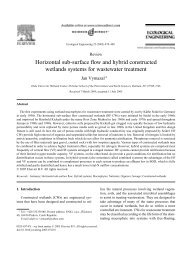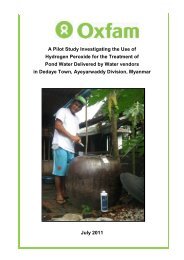Fertigation: Optimizing the Utilization of Water and Nutrients - SSWM
Fertigation: Optimizing the Utilization of Water and Nutrients - SSWM
Fertigation: Optimizing the Utilization of Water and Nutrients - SSWM
Create successful ePaper yourself
Turn your PDF publications into a flip-book with our unique Google optimized e-Paper software.
arising from <strong>the</strong> need to prepare fertilizer solutions led to <strong>the</strong> development <strong>of</strong><br />
services supplying liquid fertilizer blends according to specific recipes, as<br />
ordered by growers to meet specific plant dem<strong>and</strong>s, matched to particular<br />
growing stages <strong>and</strong> climatic conditions (Prenger et al., 2001). In <strong>the</strong> highly<br />
sophisticated industry <strong>of</strong> greenhouse cultivation, clean acid <strong>and</strong> bases are stored,<br />
<strong>and</strong> <strong>the</strong> instantaneous supply <strong>of</strong> nutrients to <strong>the</strong> irrigation line is controlled<br />
continuously, on site, by computer.<br />
The conventional method <strong>of</strong> fertilizer application before planting becomes<br />
ineffective with drip irrigation systems. Growing tomatoes on s<strong>and</strong> dunes<br />
without a daily supply <strong>of</strong> P in <strong>the</strong> trickle line resulted in a complete exhaustion<br />
<strong>of</strong> P within a radius <strong>of</strong> 10 cm around <strong>the</strong> plants by <strong>the</strong> time it was needed for <strong>the</strong><br />
developing fruits, but injection <strong>of</strong> a complete NPK fertilizer into <strong>the</strong> trickle line<br />
increased <strong>the</strong> yield by 30% (Ben Asher et al., 1974). An adequate supply <strong>of</strong><br />
nutrients <strong>and</strong> water to satisfy plant dem<strong>and</strong>s from a limited soil root volume can<br />
be achieved only by matching <strong>the</strong> supplies <strong>of</strong> water <strong>and</strong> nutrients to plant needs<br />
during <strong>the</strong> various growth stages. <strong>Fertigation</strong> enables accurate supply <strong>of</strong> water<br />
<strong>and</strong> nutrients to <strong>the</strong> individual plant, whe<strong>the</strong>r it is a corn or a cotton plant in <strong>the</strong><br />
field, or a single tree within an orchard. The daily application rate <strong>of</strong> fertigation<br />
changes during <strong>the</strong> growing season <strong>and</strong> is planned to follow plant daily dem<strong>and</strong><br />
according to its nutrients uptake strategy. Therefore, <strong>the</strong> units used in calibrating<br />
fertigation are milligrams <strong>of</strong> nutrient supplied per day per plant ra<strong>the</strong>r than<br />
kg/ha. Likewise, <strong>the</strong> unit for water supply is changing from <strong>the</strong> regular<br />
millimeters to liters per day per plant. Scaife <strong>and</strong> Bar-‐Yosef (1995) reported <strong>the</strong><br />
daily consumption <strong>of</strong> water <strong>and</strong> nutrients by crops.<br />
The fertigation technique has rapidly spread all over <strong>the</strong> world in <strong>the</strong> last 40<br />
years, <strong>and</strong> irrigation controllers are available commercially that compensate for<br />
humidity, temperature <strong>and</strong> wind effects. In dealing with factors that modify<br />
temperature <strong>and</strong> humidity, a solar integrator can automatically increase <strong>the</strong><br />
frequency <strong>of</strong> irrigations in sunny, hot dry wea<strong>the</strong>r <strong>and</strong> reduce it in dull, cool,<br />
damp wea<strong>the</strong>r. A rain override could also be used for outdoor crops: such a<br />
controller may initiate a single irrigation station as a trigger <strong>and</strong> <strong>the</strong>n<br />
sequentially activate many o<strong>the</strong>r stations. All <strong>the</strong>se instruments are based on<br />
physical measurements, but no easy-‐to-‐use, reliable, chemically activated<br />
automatic controllers are yet available for open-‐field crops or orchards. The<br />
quick development <strong>of</strong> trickle irrigation <strong>and</strong> fertigation systems in many parts <strong>of</strong><br />
<strong>the</strong> world followed <strong>the</strong> dem<strong>and</strong>s to minimize water use in agriculture, which<br />
arose from <strong>the</strong> shortage <strong>of</strong> water caused by increasing urban dem<strong>and</strong>s.<br />
Development was also driven by increasing labor costs, dem<strong>and</strong>s to prevent<br />
pollution <strong>and</strong> to minimize soil erosion, increasing reliance on saline water<br />
sources, <strong>and</strong> unfavorable soil quality <strong>and</strong> wind conditions.<br />
11



